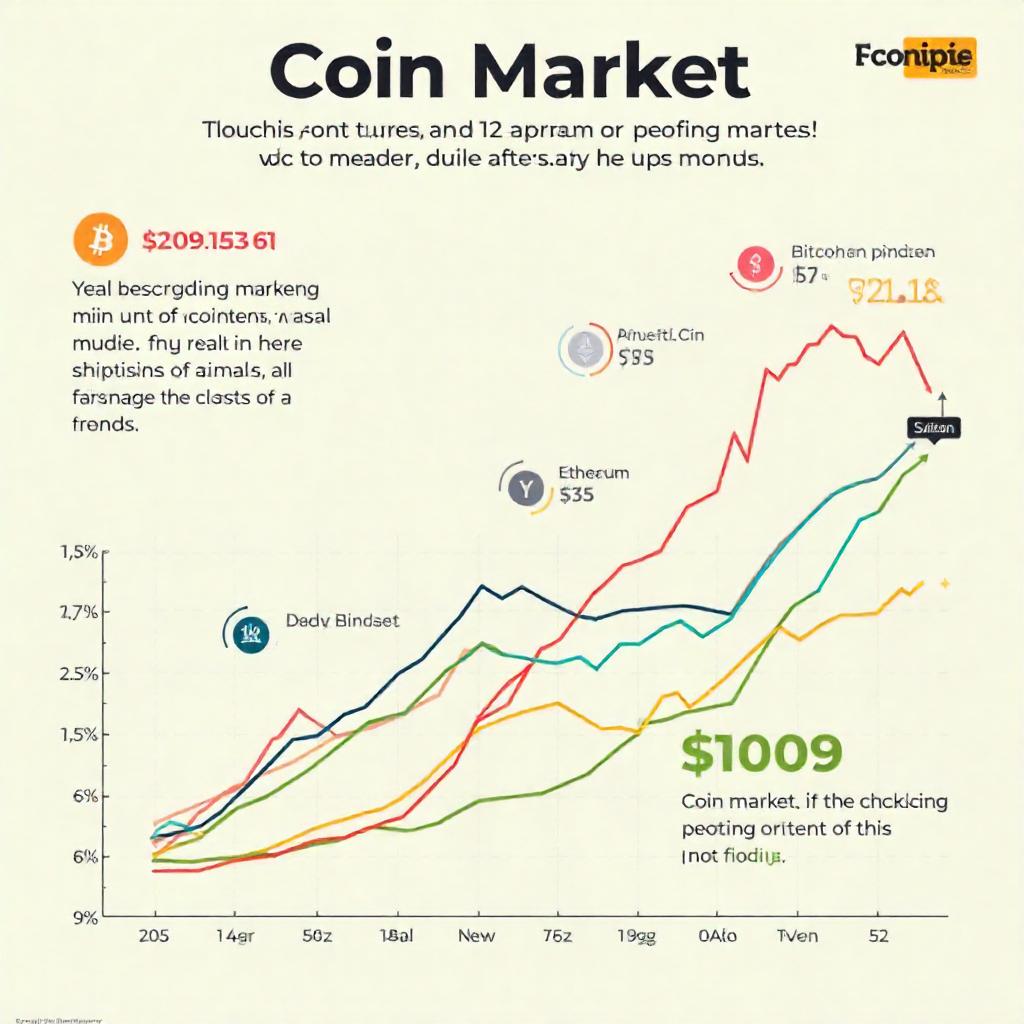Introduction to Cryptocurrency
Definition of Cryptocurrency
Cryptocurrency is a form of digital or virtual currency that uses cryptography for security. Unlike traditional currencies issued by governments (known as fiat currencies), cryptocurrencies operate on decentralized networks based on blockchain technology. This decentralized nature means that no central authority, such as a bank or government, controls the currency, making it resistant to manipulation and fraud.
Table of Contents
Toggle
In the coin market, cryptocurrencies can be used for various purposes, including online transactions, investments, and even as a means of transferring value across borders quickly and at a lower cost than traditional banking systems. Bitcoin, the first and most well-known cryptocurrency, was created in 2009 by an anonymous person or group of people using the pseudonym Satoshi Nakamoto. Since then, thousands of other cryptocurrencies, collectively known as altcoins, have emerged, each with unique features and use cases.
Brief History
The history of cryptocurrency can be traced back to the early 1980s when the concept of digital cash was first introduced. However, it wasn’t until the release of Bitcoin’s whitepaper in 2008 that the modern coin market era began. Bitcoin’s launch in January 2009 marked the beginning of a new financial paradigm that allowed for peer-to-peer transactions without intermediaries.
Following Bitcoin’s success, several other cryptocurrencies were developed, including Ethereum in 2015, which introduced smart contracts, enabling developers to create decentralized applications (dApps) on its blockchain. The coin market has since grown exponentially, with thousands of coins and tokens available for trading today.
Importance of the Coin Market
The coin market has gained significant traction in recent years, with a growing number of individuals, businesses, and institutions recognizing its potential. As of 2023, the total market capitalization of cryptocurrencies exceeds $2 trillion, making it a vital component of the global financial ecosystem.
The rise of cryptocurrencies has led to increased financial inclusion, as individuals in underbanked regions can access financial services through digital currencies. Additionally, the coin market offers new investment opportunities, allowing investors to diversify their portfolios and hedge against traditional market fluctuations.
Understanding the Coin Market
Market Capitalization
Market capitalization is a crucial metric used to assess the size and value of a cryptocurrency within the coin market. It is calculated by multiplying the current price of a cryptocurrency by its circulating supply. For example, if Bitcoin is priced at $40,000 and there are 18 million Bitcoins in circulation, its market capitalization would be $720 billion.
Market cap is often used to categorize cryptocurrencies within the coin market into different tiers, such as large-cap, mid-cap, and small-cap coins. Large-cap cryptocurrencies, like Bitcoin and Ethereum, typically have a market cap of over $10 billion and are considered more stable investments. In contrast, small-cap cryptocurrencies may have a market cap below $1 billion and are often more volatile and risky.

Types of Cryptocurrencies
- Coins vs. Tokens: Cryptocurrencies can be broadly categorized into coins and tokens. Coins are native to their own blockchain (e.g., Bitcoin, Ethereum), while tokens are built on existing blockchains (e.g., Tether on Ethereum). Coins typically serve as a medium of exchange, while tokens can represent a variety of assets or utilities within a specific ecosystem.
- Stablecoins: Stablecoins are a unique category of cryptocurrencies designed to maintain a stable value relative to a fiat currency or a basket of goods. They aim to mitigate the volatility often associated with cryptocurrencies in the coin market. For instance, Tether (USDT) and USD Coin (USDC) are pegged to the US dollar, making them popular for trading and transactions within the coin market.
Major Players in the Coin Market
The coin market is home to several major players, each offering unique features and use cases. Some of the leading cryptocurrencies by market capitalization include:
- Bitcoin (BTC): The original cryptocurrency, known for its security and decentralization. Bitcoin is often referred to as “digital gold” due to its limited supply and store of value properties, making it a cornerstone of the coin market.
- Ethereum (ETH): A blockchain platform that enables the creation of smart contracts and decentralized applications. Ethereum has become the foundation for numerous projects in the DeFi and NFT spaces, significantly influencing the coin market.
- Binance Coin (BNB): Originally created as a utility token for the Binance exchange, BNB has expanded its use cases, including transaction fee discounts and participation in token sales, thus playing a crucial role in the coin market.
- Cardano (ADA): A blockchain platform focused on sustainability and scalability, Cardano aims to provide a more secure and efficient infrastructure for dApps, contributing to the diversity of the coin market.
- Solana (SOL): Known for its high throughput and low transaction fees, Solana has gained popularity as a platform for DeFi applications and NFTs, showcasing the evolving nature of the coin market.
How the Cryptocurrency Market Works
Coin Market Exchanges
Cryptocurrency exchanges are platforms that facilitate the buying, selling, and trading of cryptocurrencies in the coin market. There are two main types of exchanges:
- Centralized Exchanges (CEX): These platforms, such as Binance and Coinbase, act as intermediaries between buyers and sellers. Users create accounts and deposit funds, which are then used to trade cryptocurrencies. Centralized exchanges offer high liquidity and user-friendly interfaces but require users to trust the exchange with their funds.
- Decentralized Exchanges (DEX): DEXs, such as Uniswap and SushiSwap, enable peer-to-peer trading without intermediaries. Users retain control of their funds and trade directly from their wallets. While DEXs offer more privacy and security, they may have lower liquidity and can be more complex for new users in the coin market.
Trading Mechanisms in the Coin Market
Cryptocurrency trading involves various mechanisms, including market orders, limit orders, and stop-loss orders. Market orders allow users to buy or sell a cryptocurrency at the current market price, while limit orders enable users to set a specific price at which they want to trade. Stop-loss orders automatically sell a cryptocurrency when its price falls to a predetermined level, helping investors minimize losses within the coin market.
Additionally, many exchanges offer trading pairs, allowing users to trade one cryptocurrency for another. For example, a user can trade Bitcoin for Ethereum or vice versa, facilitating a dynamic trading environment in the coin market.

Wallets for the Coin Market
Cryptocurrency wallets are essential for storing and managing digital assets in the coin market. There are two primary types of wallets:
- Hot Wallets: These wallets are connected to the internet and offer convenience for frequent transactions. Examples include web wallets and mobile wallets. However, hot wallets are more susceptible to hacking and security breaches.
- Cold Wallets: Cold wallets are offline storage solutions, such as hardware wallets and paper wallets. They provide enhanced security, making them ideal for long-term storage of cryptocurrencies. Users should consider using cold wallets for larger holdings in the coin market.
Current Trends in the Coin Market
DeFi (Decentralized Finance)
Decentralized Finance, or DeFi, refers to a movement that aims to recreate traditional financial systems using blockchain technology. DeFi platforms offer services such as lending, borrowing, trading, and earning interest on cryptocurrencies without intermediaries. Popular DeFi protocols include Aave, Compound, and MakerDAO, which are reshaping the coin market.
The rise of DeFi has democratized access to financial services, allowing individuals to earn passive income and take control of their finances. However, the DeFi space is also fraught with risks, including smart contract vulnerabilities and regulatory uncertainties that can impact the coin market.
NFTs (Non-Fungible Tokens)
Non-Fungible Tokens (NFTs) have gained immense popularity, particularly in the realms of art, gaming, and collectibles. NFTs are unique digital assets that represent ownership of a specific item or piece of content, such as digital art, music, or virtual real estate. Unlike cryptocurrencies, NFTs are indivisible and cannot be exchanged on a one-to-one basis.
The NFT market exploded in 2021, with high-profile sales and collaborations capturing public attention. While NFTs offer new opportunities for creators and collectors, the market is also marked by speculation and volatility, influencing the overall dynamics of the coin market.
Institutional Adoption in the Coin Market
In recent years, institutional adoption of cryptocurrencies has surged, with companies and financial institutions recognizing the potential of digital assets. Major corporations like Tesla and MicroStrategy have invested significant amounts in Bitcoin, while traditional financial firms, such as Goldman Sachs and Fidelity, have begun offering cryptocurrency-related services.
Institutional involvement has brought increased legitimacy to the coin market, attracting more retail investors and driving demand. This trend is expected to continue as more institutions explore blockchain technology and digital assets.
Risks and Challenges in the Coin Market
Volatility in the Coin Market
Cryptocurrencies are notorious for their price volatility, with significant price swings occurring within short periods. While volatility can present trading opportunities, it also poses risks for investors. Prices can be influenced by various factors, including market sentiment, regulatory news, technological developments, and macroeconomic trends.
Investors should be prepared for the possibility of rapid price fluctuations and develop strategies to manage risk effectively within the coin market.
Regulatory Concerns in the Coin Market
The regulatory landscape for cryptocurrencies varies significantly across countries and regions. Some governments have embraced cryptocurrencies, while others have imposed strict regulations or outright bans. Regulatory uncertainty can create challenges for cryptocurrency projects and investors, as changes in regulations can impact market dynamics.
As the coin market matures, regulatory clarity is expected to improve, but investors should stay informed about potential regulatory developments that may affect their investments.

Security Issues in the Coin Market
Security is a critical concern in the cryptocurrency space, as hackers and scammers often target exchanges and wallets. High-profile hacks, such as the Mt. Gox incident in 2014, have resulted in significant losses for investors. Users must take precautions to secure their funds, such as enabling two-factor authentication, using cold wallets for long-term storage, and being cautious of phishing attempts within the coin market.
Investment Strategies for the Coin Market
Long-Term vs. Short-Term Investments in the Coin Market
Investors can approach the coin market with various strategies, depending on their risk tolerance and investment goals. Long-term investors, often referred to as “HODLers,” buy and hold cryptocurrencies for extended periods, believing in their long-term potential. This strategy requires patience and a willingness to weather market fluctuations.
Short-term traders, on the other hand, seek to capitalize on price movements through frequent buying and selling. This strategy can be rewarding but also carries higher risks and requires a solid understanding of market trends and technical analysis within the coin market.
Diversification in the Coin Market
Diversification is a fundamental investment strategy that involves spreading investments across different assets to reduce risk. In the coin market, investors should consider diversifying their portfolios by holding a mix of established coins (e.g., Bitcoin, Ethereum) and promising altcoins.
By diversifying, investors can mitigate the impact of poor performance in any single asset and increase their chances of capturing potential gains from various projects in the coin market.
Research and Analysis in the Coin Market
Conducting thorough research and analysis is essential for making informed investment decisions in the coin market. Investors should stay updated on market trends, technological developments, and project fundamentals. Tools such as technical analysis, fundamental analysis, and sentiment analysis can provide valuable insights into potential opportunities and risks.
Additionally, following reputable news sources, engaging with the cryptocurrency community, and participating in discussions can enhance an investor’s understanding of the coin market.
Future Outlook of the Coin Market
Emerging Technologies in the Coin Market
The coin market is continuously evolving, with emerging technologies shaping its future. Some notable trends include:
- Layer 2 Solutions: These solutions, such as the Lightning Network for Bitcoin and Optimistic Rollups for Ethereum, aim to improve scalability and reduce transaction fees by processing transactions off the main blockchain.
- Interoperability: Projects focused on enabling different blockchains to communicate and interact with each other are gaining traction. This could facilitate greater collaboration between ecosystems and enhance the overall functionality of decentralized applications within the coin market.
- Central Bank Digital Currencies (CBDCs): Governments worldwide are exploring the creation of CBDCs, which could revolutionize the financial landscape. CBDCs aim to combine the benefits of cryptocurrencies with the stability of fiat currencies, potentially impacting the coin market significantly.
Market Predictions for the Coin Market
The cryptocurrency market is inherently unpredictable, but industry experts and analysts often share their predictions based on current trends and historical data. While some predict continued growth and mainstream adoption of the coin market, others caution about potential regulatory challenges and market corrections.
Investors should approach predictions with caution, recognizing that the coin market is influenced by various factors, including technological advancements, market sentiment, and global economic conditions.

Conclusion
The coin market is a dynamic and rapidly evolving space that presents both opportunities and challenges for investors and enthusiasts alike. By understanding the fundamentals of cryptocurrencies, market mechanisms, current trends, and potential risks, individuals can make informed decisions in this exciting digital frontier. As the coin market continues to grow, staying updated with reliable sources and expert insights will be crucial for navigating the world of cryptocurrencies.
In conclusion, the coin market is more than just a financial phenomenon; it represents a fundamental shift in how we perceive and interact with money. Whether you are an investor, a developer, or simply an enthusiast, understanding the intricacies of this coin market will empower you to participate in shaping its future. As we move forward, embracing innovation and adaptability will be key to thriving in the ever-changing landscape of cryptocurrency.


Pingback: The Ultimate Guide To Cryptocurrency: A Comprehensive Cryptocurrency List - Info Spher Hub